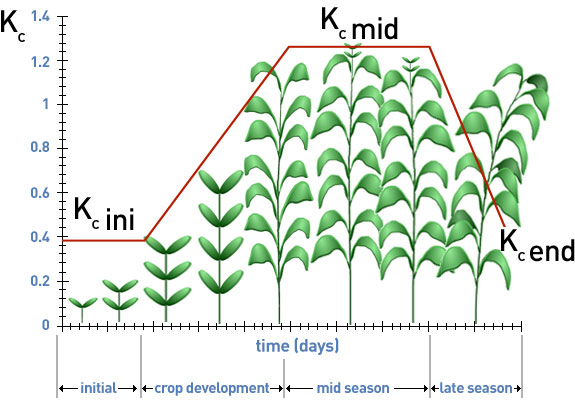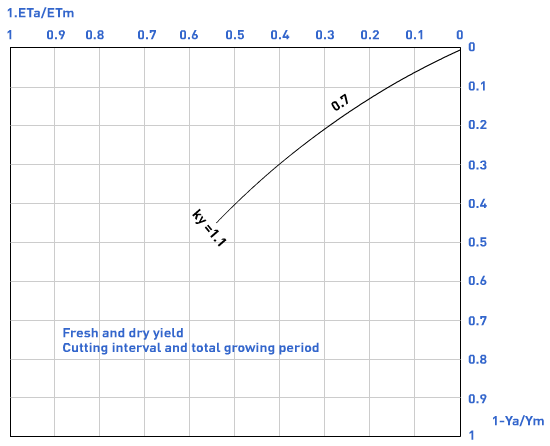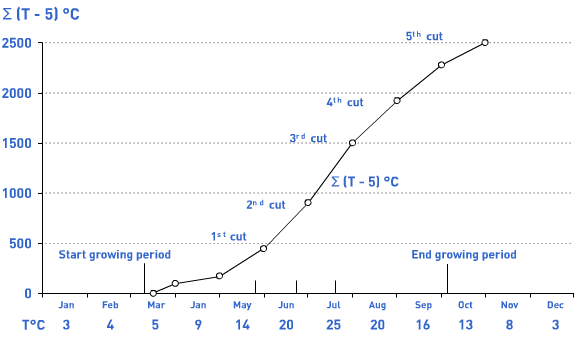Alfalfa
This section presents information on water relations and water management of alfalfa and provides links to other sources of information.
Crop Description and Climate
Crop Description and Climate
Alfalfa (Medicago sativa) is believed to have originated in the Mediterranean region. It is grown as a forage crop, either for fresh produce or for hay. The crop is grown under a wide range of climates where average daily temperature during the growing period is above 5°C. The optimum temperature for growth is about 25°C and growth decreases sharply when temperatures are above 30°C and below l0°C. In warm climates the production is higher under dry as compared to humid conditions. Alfalfa can be used as an important break crop in the rotation and most crops can follow alfalfa with the exception of certain root crops such as sugarbeet, because of the high amount of root residue left in the soil.
Alfalfa is a perennial crop and produces its highest yields during the second year of growth. In climates with mild winters, alfalfa is grown for 3 to 4 years continuously, but in continental climates with cold winters it is grown for 6 to 9 years, with a dormant period in winter. The crop is also grown as a short season annual crop. Following seeding, the crop takes about 3 months to establish. Number of cuts varies with climate and ranges between 2 and 12 per growing season. Also, yield per cut for a given location varies over the year due to climatic differences.
Water use by the crop in relation to its production is high when compared to other forage crops such as forage maize, and when economic conditions permit alfalfa is replaced by maize as a forage crop.
Alfalfa is successfully grown on a wide variety of soils, with deep, medium textured and well-drained soils being preferred. Fertilizer requirements vary with production level and are 55 to 65 kg/ha P and 75 to 100 kg/ha K. (Fertilizer requirements (kg nutrient/ha) of high-producing varieties under irrigation; accurate amounts are to be obtained from local research results or to be determined by experiments, soil testing and plant analysis and evaluation of economic conditions. Conversion: 1 kg P = 2.4 kg P2O51 kg K = 1.2 kg K2O.) Alfalfa is capable of fixing atmospheric nitrogen which meets its requirements for high yields. However, a starter of approximately 40 kg N is beneficial for good, early growth.
The crop is moderately sensitive to soil salinity. Yield decrease related to electrical conductivity (ECe of extraction saturated paste in mmhos/cm) is: 0% at ECe 2.0 mmhos/cm, 10% at 3.4, 25% at 5.4, 50% at 8.8, and 100% at ECe 15.5 mmhos/cm.
The graph below depicts the crop stages of alfalfa, and the table summarises the main crop coefficients used for water management.

Stages of | Plant | Region | |||||
|---|---|---|---|---|---|---|---|
Crop | Initial | Crop | Mid-season | Late | Total |
| |
Stage length, | 10 | 30 | var. | var. | var. | ||
Stage length, | 10 | 20 | 20 | 10 | 60 | Jan | Calif., USA |
Stage length, | 5 | 10 | 10 | 5 | 30 | Mar | Calif., USA |
Depletion | - | - | - | - | 0.55 |
|
|
Root Depth, m | - | - | - | - | - | ||
Crop Coefficient, Kc: Afalfa Hay | 0.40 | >> | 0.951 | 0.90 | - | ||
Yield Response Factor, Ky | - | - | - | - | 1.1 |
| |
1 This Kcmid cooefficient for hay crops is an overall average Kcmid cooefficient that averages Kc for both before and following cuttings. It is applied to the period following the first development period until the beginning of the last late season period of the grwoing season.
These Kc coeffecients of the for hay crops represent immediately following cutting; at full cover; and immediately before cutting respectively. The growing season is described as a series of individual cutting periods.
Water Requirements
Water Requirements
Crop water requirements (ETm) are between 800 and 1600 mm/growing period depending on climate and length of growing period. The variation in water requirements in each cutting interval for alfalfa is similar to that during the total growing period from sowing to harvest for other crops. The kc value is about 0.4 just after cutting, increasing to 1.05 to l.2 just prior to the next cutting with a mean value of 0.85 to 1.05. For seed production, the kc value is equal to 1.05 to 1.2 during full cover until the middle of flowering, after which the kc value is reduced sharply.
Water Supply And Crop Yield
Water Supply And Crop Yield
The relationships between relative yield decrease (1 - Ya/Ym) and relative evapotranspiration for alfalfa are shown in the figure below.

To stimulate root growth, the young stand should be irrigated frequently because root development is adversely affected by dryness. During each cutting interval the amount of total green matter produced increases to a maximum at the start of flowering when the quality for hay production is also at its best. To enhance growth, irrigation is normally applied just after cutting. When irrigation is applied just before cutting the top soil may still be wet at the time of cutting, hampering cutting and causing the cut material to mould more easily.
Excess irrigation may cause reduced soil aeration which is particularly harmful to the crop. During winter, when the crop i s dormant or growing very slowly, the crop will tolerate short periods of flooding without causing much damage to the later growth of the crop.
The relationship between relative yield decrease (1 - Ya/Ym) and relative evapotranspiration deficit (1 - ETa/ETm) is given in Figure 6. Within a certain range of relative evapotranspiration deficit (0 to 0.4), the yield response factor (ky) for both fresh and dry yield is smaller than one. This implies that water utilization efficiency (Ey) (kg of produce/m3 of water) increases in this range of relative water deficit. Under conditions of limited water supply, overall production is increased by extending the area under irrigation rather than by meeting full crop water requirements over a limited area. Also, the effect of a reduced water supply on yield of alfalfa is less pronounced than that of many other crops that have ky values greater than one during the period of water shortage. Where cropping of several crops is involved, the irrigation supply to alfalfa may be reduced in favour of more sensitive crops.
To reduce peak demands for water during the hot summer months, a dormancy period during these months is sometimes practised in North Africa. Water savings are utilized during spring and autumn when climatic conditions allow high yields with relatively lower water requirements. Where the crop is grown for seed, effective water savings may be made by timing the seed production during the period when normal water demands of a forage crop would be high.
The 'drought tolerance' of alfalfa, sometimes claimed during periods of low water requirements, appears to be due to its extensive rooting system which enables the crop to draw water from a large soil volume.
Cutting Interval
Cutting Interval
Cuts are normally taken at the start of flowering when the vegetative growth slows down. Temperature has a pronounced effect on cutting interval and cutting interval at different mean daily temperatures is:
Tmean, °C | 10 | 15 | 20 | 25 | 30 | 35 |
|---|---|---|---|---|---|---|
Interval, days | (100) | 50 | 35 | 25 | 20 | 18 |
When water and other growth factors are not limiting, a first indication of the time and number of cuts for a given location can be obtained from the summation of daily mean temperature (T) above 5°C and the time of cut is found when the sum T - 5 = 500 to 550 degree days.
Following figure shows an example of cutting intervals over the growing period.

Water Uptake
Water Uptake
Alfalfa has a deep rooting system extending up to 3 m in deep soils. The maximum root depth is reached after the first year. The crop can draw water from great soil depth and little response to irrigation has been shown with groundwater tables at 2 m or higher. Normally, when the crop is fully grown, 100 percent of the water is extracted from the first 1 to 2 m soil depth (D = 1-2 m). When maximum evapotranspiration (ETm) is 5 to 6 mm/day, about 50 percent of the total available soil water can be depleted before the uptake of water from the soil affects crop evapotranspiration (or p = 0. 5). After cutting full cover is reached in 12 to 20 days depending on temperature, and peak ETm is reached soon after.
Irrigation Scheduling
Irrigation Scheduling
To obtain maximum yields under conditions where water supply is not limited, an adequate supply to; meet crop water requirements during the whole cutting, interval is advisable. Irrigation practice for hay production varies with an application just after cutting to enhance rapid growth, or at the time when the crop is reaching full cover and water requirements are near maximum. Irrigation immediately following removal of the cut crop is often practised on land difficult to irrigate. Late application may result in soil remaining wet, thus delaying the drying of hay on the ground. For conditions free from water stress and depending on the level of maximum evapotranspiration (ETm), a soil water depletion level of about 50 percent of the total available soil water (p = 0.5) is permissible.
Irrigation Methods
Irrigation Methods
Surface irrigation is commonly used in alfalfa production. The most common method is border irrigation. Contour irrigation and wild flooding are sometimes practised. Where water is scarce or the soil permeability is high, water is supplied by overhead sprinkling.
Yield
Yield
Crop yield varies with climate and length of total growing period. Good yields after the first year are in the range of 2 to 2. 5 tons/ha per cut (hay with 10 to 15 per cent moisture) of about 25 to 30 day cutting interval. For example, Hofuf, Saudi Arabia, 28 ton/ha of hay over 310 days involving 12 cuts; Davis, California, under experimental conditions, 22 ton/ha of hay over 200 day growing period involving 7 cuts. The water utilization efficiency for harvested yield (Ey) of hay with 10 to 15 percent moisture is 1. 5 to 2.0 kg/ m3after the first year. The moisture content of fresh green matter is about 80 percent. From 18 to 20 percent of the dry weight is protein.

